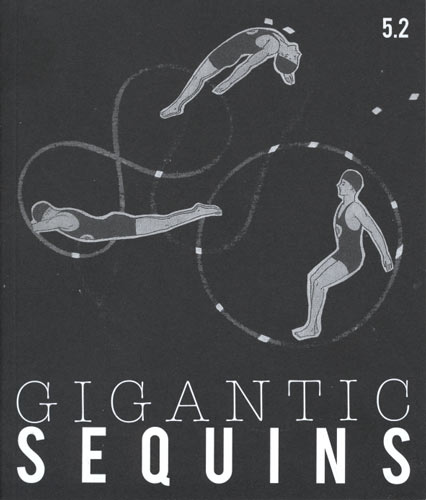Gigantic Sequins – 2014
Literature is at its best when it resonates, when the reader is inclined to make connections to other texts, genres, and media in an effort to make sense of the work at hand. The resonant quality of the summer issue of Gigantic Sequins is high, indebted to the finely crafted works within its pages. According to Editor-in-chief Kimberly Ann Southwick, “The whole reason we do this thing is to present you some of the finest writers and artists around these days.” In this issue, they have fulfilled this promise. Literature is at its best when it resonates, when the reader is inclined to make connections to other texts, genres, and media in an effort to make sense of the work at hand. The resonant quality of the summer issue of Gigantic Sequins is high, indebted to the finely crafted works within its pages. According to Editor-in-chief Kimberly Ann Southwick, “The whole reason we do this thing is to present you some of the finest writers and artists around these days.” In this issue, they have fulfilled this promise.
The fiction, nonfiction, and poetry in this issue could fall into categories: surreal, experimental, lyric. All have these qualities embedded in their diction, producing tone original and sometimes haunting. Justin Brouckaert’s “Love Stories,” opens the issue with a collection of seven distinct pairings of lovers who may or may not be human or even alive but have found a relationship with another; Brouckaert deftly describes and makes manifest the inherent love illustrating not only that love exists in all places and things, but that it is sometimes the loneliest of human emotions. Hills, tarps, anteaters, and humans experience love in these stories that echo after the eyes have left the page:
A skeleton sleeps for a long time.
he wakes & picks a hair from his eye.
This isn’t mine, he says.
This fifth story in Brouckaert’s collection breathes the loneliness into the reader’s face. Other pieces in the issue contain a similar quality of revealing without saying too much. Minimal could describe the properties of the works in the issue too, but the emotions purged are delicate, intense, and abundant. “A Man Eats Another Man’s Heart,” a lyric essay by Caitlyn Luce Christensen, conjures familiar thematic elements and wrings each premise dry until the fact of one man eating another’s heart is accepted and acknowledged as possible in the transcendent world the writer has created. It is reminiscent of Stephen Crane’s poem “In the Desert,” yet moving beyond the knowledge to the power behind it. In one account in the essay, “A man eats another man’s heart,” which is how each piece within the piece begins, followed by “You are the heart. Artists will attempt to replicate you. Pop stars will sing songs about you.” One can only hope to be thus remembered, with this essay exploring a number of incarnations of a metaphorically consumed heart worthy of further contemplation.
The poems in this issue are lyric and enigmatic, elusive of definition or categorization. The nearest adjective would be surreal, followed closely by experimental. Only one of the four poems, “Self Portrait Without My Dead Sister” by Caleb Curtiss, could be described as narrative, but this classification is hazy and just out of reach. The poems, including this one, surprise and confound even as the words move together smoothly to create a work of art. In Curtiss’s poem, there is an immense loneliness in thinking of the universe as “expanding in all of its bovine splendor, / leaving behind its quivers of matter, its great clumps / of time.” In this and the other poems exists great sorrow and melancholy in lines such as “Be. Fifteen. Was. This is how flames / will paraphrase us all,” in Nick Flynn’s “The Book of Ash,” and in the speaker’s definition of himself as “a fool like Aschenbach, / like Juliet, like Jesus,” in “The Painter” by Patrick Clement James. Finally, Tanya Muzumdar’s “From a Crow’s Nest” presents an inscrutable and familiar “shifting Kansas” with words and images, extant yet unattainable.
The melancholy flows through much of this issue in each genre. Rachel Richardson, in her creative nonfiction piece “Love Story,” reminisces about time before the narrator was born, and searching through her parents’ history, sums up her own reason for being that is somehow a confluence of events, errors, and missteps. She presents the reader with “the events and moments and chances that made me. I carry them like talismans, unpredictable, unbelievable: a shattered bone,” as if her existence is surprising since it came out of a fumbling humanity unaware of itself. This backward march through time brings everything to the foreground. Similarly, Michelle E. Crouch’s “Wolves Raised by Girls” explores existence in a work of fiction that reads like a memoir ringing of truth in a primal world of nature where “The poachers begin to thicken in the trees and instead of doe and hart we hunted men.” This world is authentic even in the absurdities.
The provocative artwork throughout the issue is accompanied by artists’ statements revealing responses to questions of motivation, origin, and meaning. Linger over “Satan’s Cheerleaders” by Aaron Morgan and “Sonnet” by Julie Drallos. Contemplate allegory in Dmitry Borshch’s “Betrothal of the Virgins” and “The Making of Brothers.”
The summer issue culminates in editorial book reviews and biographical notes on the artists and writers. This self-proclaimed journal of “almost-but-not-quite square pages in black and white ink” is home to worthy pieces of art and writing that readers will return to spend time with long after the echoes have subsided.
[www.giganticsequins.com]





